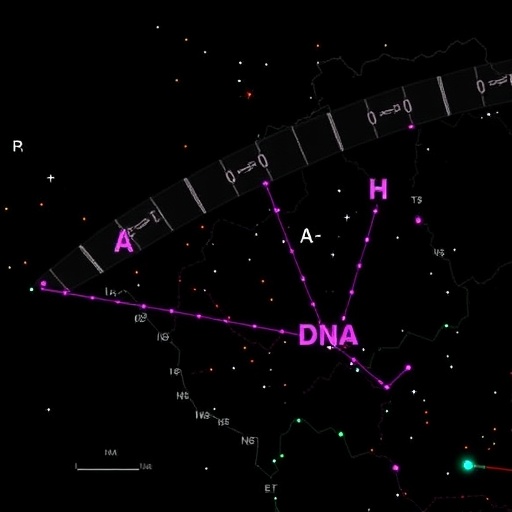In groundbreaking new research published in BMC Cancer, scientists have unveiled intricate molecular dynamics orchestrated by decitabine, a widely used hypomethylating agent (HMA), at pericentromeric satellite 2 DNA repeats—unraveling novel facets of epigenetic regulation in acute myeloid leukemia (AML). Decitabine, known chemically as 5-aza-2′-deoxycytidine (DAC), is a cornerstone in the therapeutic arsenal against myelodysplastic syndromes (MDS) and AML, both devastating hematological malignancies characterized by aberrant DNA methylation patterns. While its capacity to demethylate gene promoters has been extensively studied, this new study uncovers the hitherto elusive epigenetic fate of satellite DNA sequences during and after DAC treatment.
The significance of satellite 2 repeats, situated in the pericentromeric heterochromatin regions, lies in their crucial role in maintaining chromosomal stability and ensuring proper mitotic segregation. These repetitive sequences are densely populated with CpG dinucleotides, the primary targets for DNA methylation—a chemical modification pivotal for genome integrity. Aberrant methylation at these loci can precipitate genomic instability, a hallmark of cancer progression. Therefore, understanding how therapeutic demethylating agents influence satellite DNA is essential for refining treatment paradigms.
Employing the human AML cell line U937 as a model, the researchers meticulously charted DNA methylation changes at satellite 2 repeats during DAC exposure and subsequent recovery periods. Initial findings revealed a pronounced demethylation of these satellite sequences following treatment. This observation aligns with DAC’s established mechanism where it integrates into DNA, covalently traps DNA methyltransferases (DNMTs), notably DNMT1, and leads to their depletion, culminating in passive DNA demethylation during replication.
However, the study’s revelation came with the dynamic recovery phase: after 48 hours in culture post-treatment cessation, satellite 2 DNA methylation was astonishingly restored to pre-treatment levels. This restitution suggests a robust cellular mechanism counteracting the demethylating pressure imposed by DAC. Delving into the molecular underpinnings, the team identified a significant upregulation of DNMT3B expression, a de novo DNA methyltransferase known to have a predilection for satellite 2 repeats, concomitant with the remethylation event.
Intriguingly, chromatin modifications at the DNMT3B promoter emerged as a key regulator in this process. The researchers detected increased histone H3 acetylation—a marker of chromatin relaxation and transcriptional activation—specifically at the DNMT3B promoter in DAC-treated cells. This finding suggests that decitabine not only triggers hypomethylation but can indirectly enhance the transcription of genes encoding methylating enzymes, possibly as a compensatory feedback loop to restore epigenetic homeostasis.
The data paint a nuanced picture of the cellular epigenetic response to HMAs, highlighting a transient window wherein satellite DNA is vulnerable to hypomethylation and potential destabilization. Subsequent remethylation mediated by DNMT3B appears to be a cellular safeguard mechanism, arguably limiting DAC’s genomic destabilization effects. This dynamic opens a compelling avenue for future research aimed at disrupting this remethylation reset to amplify the epigenomic and cytotoxic impact of HMAs.
Considering the clinical implications, the study posits that the transient demethylation followed by remethylation at satellite sequences could undermine full therapeutic efficacy of DAC in AML and MDS patients. Satellite DNA remethylation may attenuate the genomic instability required to maximize antitumor activity, thus representing a previously unappreciated resistance mechanism. Targeting DNMT3B or modulating histone acetylation at its promoter could potentiate DAC’s cytotoxic effects by sustaining hypomethylation-induced genomic stress in leukemic cells.
Moreover, the research subtly touches on the complex interplay between DNA methylation, chromatin remodeling, and endogenous retroelement (ERE) reactivation in the context of HMA therapy. Although reactivation of EREs and the ensuing innate antiviral response have been documented as part of DAC’s cytotoxic repertoire, the specific role and timing of satellite DNA hypomethylation within this context warrant deeper investigation. The study lays the groundwork for integrating satellite repeat methylation status into the broader epigenetic landscape modulated by HMAs.
This innovative exploration into satellite 2 methylation dynamics challenges the conventional focus on gene promoter demethylation in cancer epigenetics, redirecting attention towards repetitive elements that constitute a significant portion of the genome. It underscores the need to consider the full spectrum of epigenetic alterations induced by therapeutic agents, which might collectively dictate treatment outcomes in hematologic malignancies.
Beyond immediate clinical ramifications, the findings also prompt fundamental questions about the regulation of de novo methyltransferase genes under epigenetic stress and their contribution to genome stability recovery. The observed histone acetylation changes at the DNMT3B promoter hint at epigenetic crosstalk mechanisms that could be exploited pharmacologically to tip the balance towards sustained hypomethylation and enhanced tumor cell vulnerability.
In summary, this pioneering work reveals a biphasic epigenetic response to decitabine at pericentromeric satellite 2 repeats, characterized by rapid demethylation followed by swift remethylation driven by induced DNMT3B expression. This dynamic showcases an adaptive cellular epigenetic resilience that may constrain the full therapeutic potential of HMAs in AML. These insights steer a novel trajectory for future therapeutic strategies aimed at disrupting this remethylation rebound to potentiate leukemia eradication.
The elegant interweaving of molecular biology, chromatin biochemistry, and cancer epigenetics exemplified in this study marks a significant stride towards unraveling the complexity of epigenetic therapies. As treatment resistance and partial responses continue to challenge hematologic oncology, understanding such sophisticated regulatory loops offers hope for the development of next-generation interventions that can more decisively reprogram the cancer epigenome.
This investigation not only enhances our foundational knowledge of how DAC modulates satellite DNA but also elevates the discourse on precision epigenetic targeting—a promising frontier in the ongoing fight against malignancies characterized by epigenomic alterations. As research proceeds toward clinical translation, integrating these mechanistic insights will be vital for the design of combinatorial therapies that can circumvent epigenetic resilience and improve patient outcomes.
Subject of Research: The epigenetic effects of the hypomethylating agent decitabine on pericentromeric satellite 2 DNA methylation dynamics in acute myeloid leukemia cells.
Article Title: Decitabine-mediated DNA methylation dynamics at pericentromeric satellite 2 repeats
Article References:
Sordini, E., Ciurlia, E., Zanella, A. et al. Decitabine-mediated DNA methylation dynamics at pericentromeric satellite 2 repeats. BMC Cancer 25, 1778 (2025). https://doi.org/10.1186/s12885-025-14998-w
Image Credits: Scienmag.com
DOI: 10.1186/s12885-025-14998-w (Published 18 November 2025)




